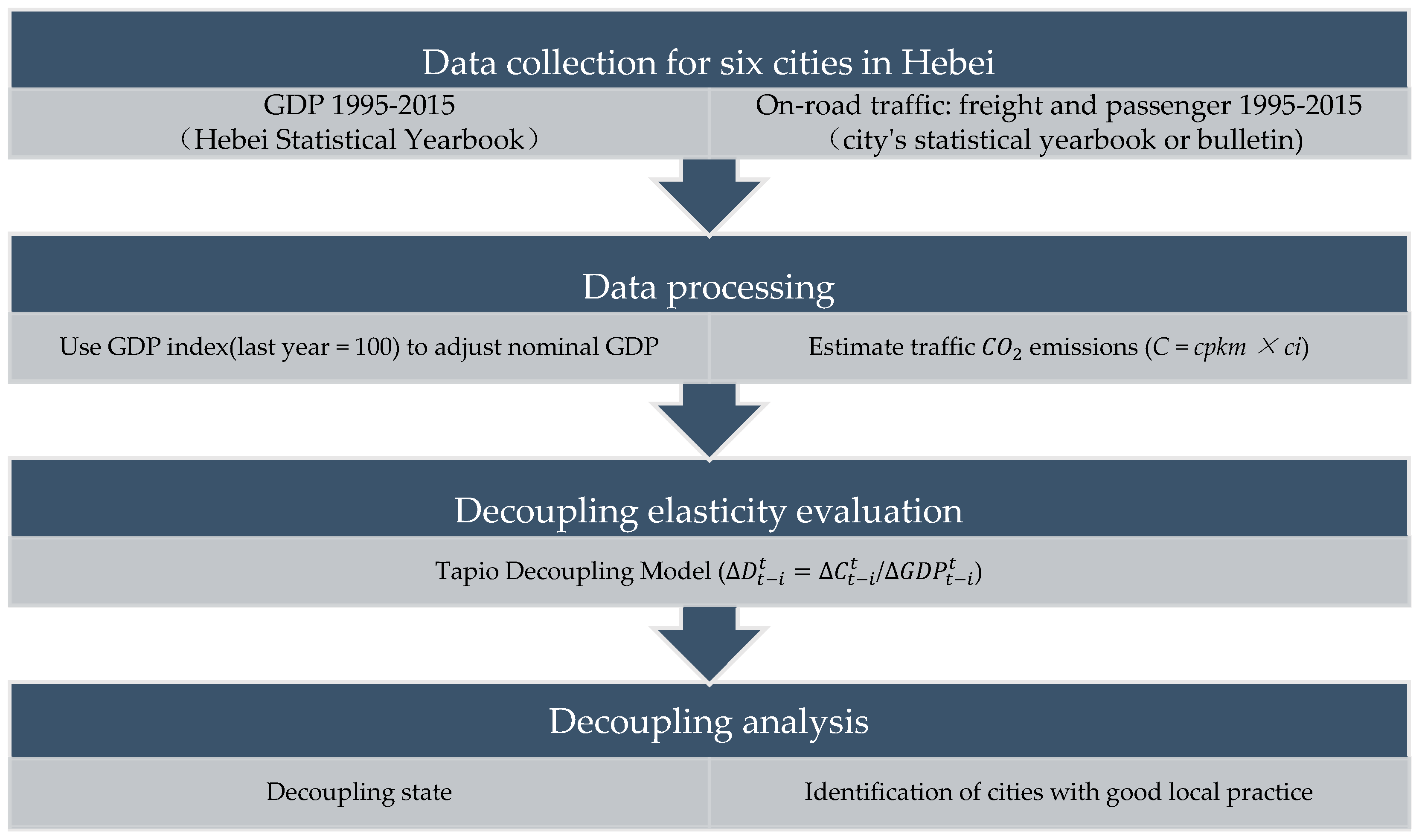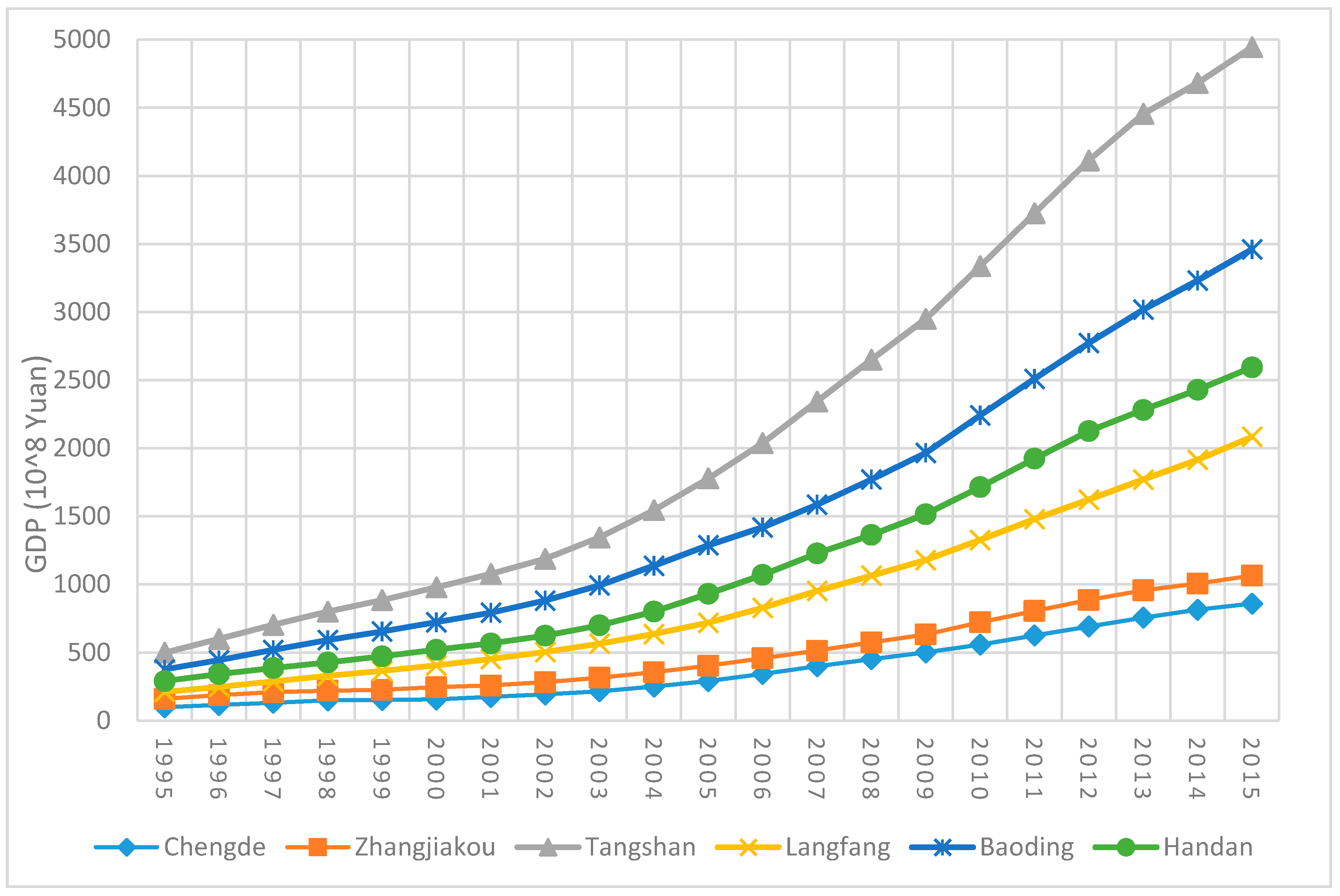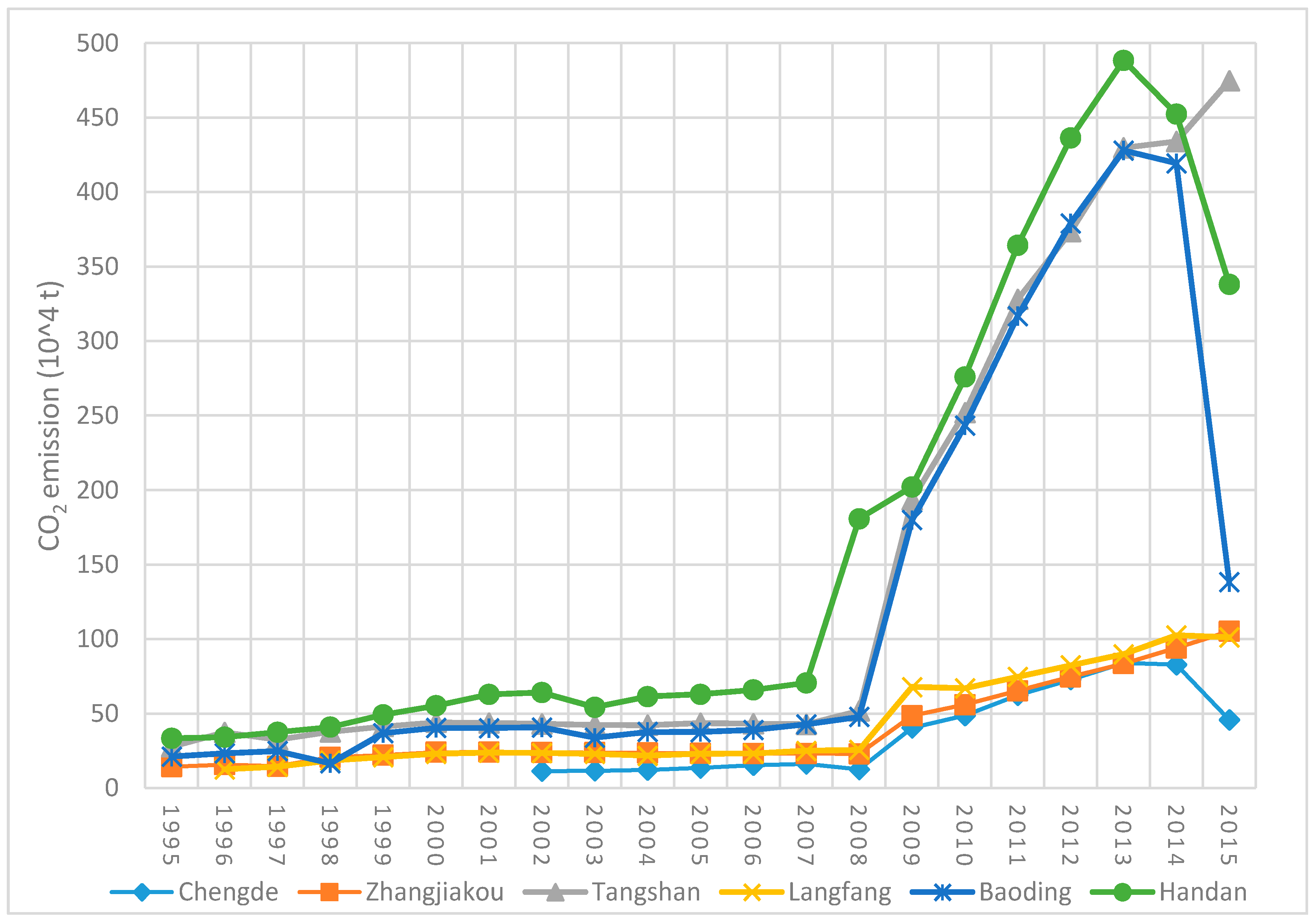Decoupling Analysis of CO2 Emissions in Transportation Sector from Economic Growth during 1995–2015 for Six Cities in Hebei, China
Abstract
:1. Introduction
2. Materials and Methods
2.1. Calculation of the CO2 Emissions in Transport Sector
2.2. Tapio Decoupling Model
2.3. Data Description
3. Results
3.1. Economic Growth and Traffic CO2 Emissions
3.2. The Decoupling Analysis
4. Discussion
5. Conclusions
Author Contributions
Funding
Conflicts of Interest
Appendix A
| City’s Statistical Yearbooks | City’s Statistical Bulletin | |
|---|---|---|
| Chengde City | 2013–2015 | 2002–2012 |
| Zhangjiakou City | 1995–2015 | - |
| Tangshan City | 1995–2015 | - |
| Langfang City | 1996–2003, 2005, 2013–2014 | 2004, 2006–2012 |
| Baoding City | 1995–2002 | 2003–2015 |
| Handan City | 1998–2015 | 1995–1997 |
References
- Yan, X.; Crookes, R.J. Reduction potentials of energy demand and GHG emissions in China’s road transport sector. Energy Policy 2009, 37, 658–668. [Google Scholar] [CrossRef]
- Li, Y.; Zheng, J.; Dong, S.; Wen, X.; Jin, X.; Zhang, L.; Peng, X. Temporal variation of local traffic CO2 emissions and its relationship with CO2 flux in Beijing, China. Transport. Res. D-TRE 2018. accepted. [Google Scholar]
- Loo, B.P.Y.; Banister, D. Decoupling transport from economic growth: Extending the debate to include environmental and social externalities. J. Transp. Geogr. 2016, 57, 134–144. [Google Scholar] [CrossRef]
- Baloch, M.A.; Suad, S. Modeling the impact of transport energy consumption on CO2 emission in Pakistan: Evidence from ARDL approach. Environ. Sci. Pollut. Res. 2018, 25, 9461–9473. [Google Scholar] [CrossRef]
- Yoke-Kee, E.; Chin-Yoong, W. Tapered US carbon emissions during good times: What’s old, what’s new? Environ. Sci. Pollut. Res. 2017, 24, 25047–25060. [Google Scholar] [CrossRef]
- Guo, J.; Zhang, Y.J. The key sectors for energy conservation and carbon emissions reduction in China: Evidence from the input-output method. J. Clean. Prod. 2018, 179, 180–190. [Google Scholar] [CrossRef]
- Tian, X.; Chang, M. Decoding the effect of socioeconomic transitions on carbon dioxide emissions: Analysis framework and application in megacity Chongqing from inland China. J. Clean. Prod. 2017, 142, 2114–2124. [Google Scholar] [CrossRef]
- Salahuddin, M.; Alam, K.; Ozturk, I. The effects of Internet usage and economic growth on CO2 emissions in OECD countries: A panel investigation. Renew. Sustain. Energy Rev. 2016, 56, 988–998. [Google Scholar] [CrossRef]
- Limin, D.U.; Wei, C.; Cai, S.H. Economic development and carbon dioxide emissions in China: Provincial panel data analysis. China. Econ. Rev. 2012, 23, 371–384. [Google Scholar] [CrossRef]
- Xu, B.; Lin, B.Q. Investigating the differences in CO2 emissions in the transport sector across Chinese provinces: Evidence from a quantile regression model. Renew. Sustain. Energy Rev. 2016, 56, 988–998. [Google Scholar] [CrossRef]
- Lin, B.Q.; Benjamin, N.I. Influencing factors on carbon emissions in China transport industry. A new evidence from quantile regression analysis. J. Clean. Prod. 2017, 150, 175–187. [Google Scholar] [CrossRef]
- Meng, X.; Ji, H. Roads, economy, population density, and CO2: A city-scaled causality analysis. Resour. Conserv. Recyl. 2018, 128, 508–515. [Google Scholar] [CrossRef]
- Arvin, M.B.; Pradhan, R.P.; Norman, N.R. Transportation intensity, urbanization, economic growth, and CO2 emissions in the G-20 countries. Util. Policy 2015, 35, 50–66. [Google Scholar] [CrossRef]
- Besma, T. CO2 emissions reduction in road transport sector in Tunisia. Renew. Sustain. Energy Rev. 2016, 56, 988–998. [Google Scholar] [CrossRef]
- Alshehry, A.S.; Belloumi, M. Study of the environmental Kuznets curve for transport carbon dioxide emissions in Saudi Arabia. Renew. Sustain. Energy Rev. 2017, 75, 1339–1347. [Google Scholar] [CrossRef]
- Sousa, C.; Roseta-Palma, C.; Martins, L.F. Economic growth and transport: On the road to sustainability. Nat. Resour. Forum 2015, 39, 3–14. [Google Scholar] [CrossRef]
- Azlina, A.A.; Law, S.H.; Mustapha, N.H.N. Dynamic linkages among transport energy consumption, income and CO2 emission in Malaysia. Energy Policy 2014, 73, 598–606. [Google Scholar] [CrossRef]
- Wang, Y.; Zhou, Y.; Zhu, L.; Zhang, F.; Zhang, Y. Influencing factors and decoupling elasticity of China’s transportation carbon emissions. Energies 2018, 11, 1157. [Google Scholar] [CrossRef]
- Zhang, Z. Decoupling China’s carbon emissions increase from economic growth: An economic analysis and policy implications. World Dev. 2000, 28, 739–752. [Google Scholar] [CrossRef]
- Organization for Economic Cooperation and Development (OECD). Indicators to Measure Decoupling of Environmental Pressure from Economic Growth; Organization for Economic Cooperation: Paris, France, 2002. [Google Scholar]
- Brizga, J.; Feng, K.; Hubacek, K. Drivers of CO2 emissions in the former Soviet Union: A country level IPAT analysis from 1990 to 2010. Energy 2013, 59, 743–753. [Google Scholar] [CrossRef]
- York, R.; Rosa, E.A.; Dietz, T. STIRPAT, IPAT and ImPACT: Analytic tools for unpacking the driving forces of environmental impacts. Ecol. Econ. 2003, 46, 351–365. [Google Scholar] [CrossRef]
- Tapio, P. Towards a theory of decoupling: Degrees of decoupling in the EU and the case of road traffic in Finland between 1970 and 2001. Transp. Policy 2005, 12, 137–151. [Google Scholar] [CrossRef]
- Timilsina, G.R.; Shrestha, A. Factors affecting transport sector CO2 emissions growth in Latin American and Caribbean countries: An LMDI decomposition analysis. Int. J. Energy Res. 2009, 33, 396–414. [Google Scholar] [CrossRef]
- Wu, D.; Yuan, C.W.; Liu, H.C. The decoupling states of CO2 emissions in the Chinese transport sector from 1994 to 2012: A perspective on fuel types. Energy Environ. 2018, 29, 591–612. [Google Scholar] [CrossRef]
- Wang, Y.H.; Xie, T.Y.; Yang, S.L. Carbon emission and its decoupling research of transportation in Jiangsu Province. J. Clean. Prod. 2017, 142, 907–914. [Google Scholar] [CrossRef]
- Dong, J.F.; Huang, J.Y.; Wu, R.W.; Deng, C. Delinking indicators on transport output and carbon emissions in Xinjiang, China. Pol. J. Environ. Stud. 2017, 26, 1045–1056. [Google Scholar] [CrossRef]
- Zhu, X.P.; Li, R.R. An analysis of decoupling and influencing factors of carbon emissions from the transportation sector in the Beijing-Tianjin-Hebei Area, China. Sustainability 2016, 9, 722. [Google Scholar] [CrossRef]
- European Commission. The Future of Transport, Focus Groups’ Report, 20th February 2009. Available online: https://ec.europa.eu/transport/themes/strategies/2009_future_of_transport_en (accessed on 10 November 2018).



| Year | ci | Year | ci | Year | ci | Year | ci |
|---|---|---|---|---|---|---|---|
| 1996 | 46.25 | 2001 | 59.28 | 2006 | 50.00 | 2011 | 43.80 |
| 1997 | 50.00 | 2002 | 57.34 | 2007 | 48.42 | 2012 | 43.74 |
| 1998 | 53.74 | 2003 | 55.39 | 2008 | 46.88 | 2013 | 43.74 |
| 1999 | 57.48 | 2004 | 53.45 | 2009 | 45.34 | 2014 | 43.74 |
| 2000 | 61.23 | 2005 | 51.50 | 2010 | 43.80 | 2015 | 43.74 |
| Increase | Decrease | |||
|---|---|---|---|---|
| Increase | Slower rate | Weak decoupling ∈ (0, 0.8] | Strong negative decoupling ∈ (−∞, 0] | |
| Approximately same rate | Expansive coupling ∈ (0.8, 1.2] | |||
| Faster rate | Expansive negative decoupling ∈ (1.2, +∞] | |||
| Decrease | Slower rate | Strong decoupling ∈ (−∞, 0] | Weak negative decoupling ∈ (0, 0.8] | |
| Approximately same rate | Recessive coupling ∈ (0.8, 1.2] | |||
| Faster rate | Recessive decoupling ∈ (1.2, +∞] | |||
| Increase | Decrease | |||
|---|---|---|---|---|
| Increase | Slower rate | Weak decoupling Chengde: 2003–2006 Zhangjiakou: 1996, 2001 Tangshan: 2000, 2005, 2014 Langfang: 2003, 2005–2008 Baoding: 1996, 1997, 2002, 2004, 2006 Handan: 2002, 2005–2007 | Strong negative decoupling none | |
| Approximately same rate | Expansive coupling Chengde: 2007 Zhangjiakou: 2000, 2010 Tangshan: 1998–1999 Langfang: 1997, 1999, 2000, 2011–2013 Baoding: 2000, 2007, 2008 Handan: 2004, 2009 | |||
| Faster rate | Expansive negative decoupling Chengde: 2009–2013 Zhangjiakou: 1998, 1999, 2009, 2011–2015 Tangshan: 1996, 2008–2013, 2015 Langfang: 1998, 2009, 2014 Baoding: 1999, 2009–2013 Handan: 1996, 1999–2001, 2008, 2010–2013 | |||
| Decrease | Slower rate | Strong decoupling Chengde: 2008, 2014, 2015 Zhangjiakou: 1997, 2002–2008 Tangshan: 1997, 2001–2004, 2006, 2007 Langfang: 2001, 2002, 2004, 2010, 2015 Baoding: 1998, 2001, 2003, 2005, 2014, 2015 Handan: 1997, 1998, 2003, 2014, 2015 | Weak negative decoupling none | |
| Approximately same rate | Recessive coupling none | |||
| Faster rate | Recessive decoupling none | |||
| Chengde | Zhangjiakou | Tangshan | Langfang | Baoding | Handan | |
|---|---|---|---|---|---|---|
| 1996 | - | 0.57 | 1.72 | - | 0.58 | 0.13 |
| 1997 | - | −0.58 | −0.76 | 0.82 | 0.39 | 0.75 |
| 1998 | - | 7.91 | 1.20 | 2.07 | −2.37 | 0.88 |
| 1999 | - | 2.28 | 0.89 | 1.09 | 11.50 | 1.91 |
| 2000 | - | 1.05 | 0.63 | 0.98 | 0.93 | 1.21 |
| 2001 | - | 0.14 | −0.10 | 0.30 | −0.04 | 1.52 |
| 2002 | - | −0.10 | −0.14 | −0.08 | 0.10 | 0.20 |
| 2003 | 0.13 | −0.08 | −0.12 | −0.21 | −1.34 | −1.27 |
| 2004 | 0.34 | −0.06 | −0.02 | −0.41 | 0.79 | 0.91 |
| 2005 | 0.67 | −0.10 | 0.21 | 0.43 | −0.02 | 0.15 |
| 2006 | 0.75 | −0.01 | −0.06 | 0.03 | 0.36 | 0.32 |
| 2007 | 0.35 | −0.04 | −0.06 | 0.55 | 0.85 | 0.49 |
| 2008 | −1.77 | −0.06 | 1.60 | 0.20 | 0.98 | 14.06 |
| 2009 | 20.27 | 11.15 | 24.22 | 15.27 | 25.16 | 1.06 |
| 2010 | 1.79 | 1.08 | 2.31 | −0.09 | 2.52 | 2.79 |
| 2011 | 2.31 | 1.45 | 2.58 | 1.00 | 2.52 | 2.63 |
| 2012 | 1.61 | 1.42 | 1.33 | 1.07 | 1.87 | 1.89 |
| 2013 | 1.65 | 1.49 | 1.81 | 1.00 | 1.47 | 1.63 |
| 2014 | −0.17 | 2.42 | 0.20 | 1.71 | −0.28 | −1.13 |
| 2015 | −8.13 | 2.05 | 1.67 | −0.14 | −9.44 | −3.72 |
| Year | Decoupling State | |||||||
|---|---|---|---|---|---|---|---|---|
| Comparative Literature | This Research | |||||||
| China | Hebei | Chengde | Zhangjiakou | Tangshan | Langfang | Baoding | Handan | |
| 1996 | - | - | - | Weak decoupling | Expansive negative decoupling | - | Weak decoupling | Weak decoupling |
| 1997 | - | - | - | Strong decoupling | Strong decoupling | Expansive coupling | Weak decoupling | Weak decoupling |
| 1998 | - | - | - | Expansive negative decoupling | Expansive coupling | Expansive negative decoupling | Strong decoupling | Expansive coupling |
| 1999 | - | - | - | Expansive negative decoupling | Expansive coupling | Expansive coupling | Expansive negative decoupling | Expansive negative decoupling |
| 2000 | - | - | - | Expansive coupling | Weak decoupling | Expansive coupling | Expansive coupling | Expansive negative decoupling |
| 2001 | Weak decoupling | - | - | Weak decoupling | Strong decoupling | Weak decoupling | Strong decoupling | Expansive negative decoupling |
| 2002 | Expansive coupling | - | - | Strong decoupling | Strong decoupling | Strong decoupling | Weak decoupling | Weak decoupling |
| 2003 | Expansive negative decoupling | - | Weak decoupling | Strong decoupling | Strong decoupling | Strong decoupling | Strong decoupling | Strong decoupling |
| 2004 | Expansive negative decoupling | - | Weak decoupling | Strong decoupling | Strong decoupling | Strong decoupling | Weak decoupling | Expansive coupling |
| 2005 | Weak decoupling | Weak decoupling | Weak decoupling | Strong decoupling | Weak decoupling | Weak decoupling | Strong decoupling | Weak decoupling |
| 2006 | Expansive coupling | Weak decoupling | Weak decoupling | Strong decoupling | Strong decoupling | Weak decoupling | Weak decoupling | Weak decoupling |
| 2007 | Weak decoupling | Strong decoupling | Weak decoupling | Strong decoupling | Strong decoupling | Weak decoupling | Expansive coupling | Weak decoupling |
| 2008 | Weak decoupling | Strong decoupling | Strong decoupling | Strong decoupling | Weak decoupling | Weak decoupling | Expansive coupling | Expansive negative decoupling |
| 2009 | Weak decoupling | Weak decoupling | Expansive negative decoupling | Expansive negative decoupling | Expansive negative decoupling | Expansive negative decoupling | Expansive negative decoupling | Expansive coupling |
| 2010 | Expansive coupling | Weak decoupling | Expansive negative decoupling | Expansive coupling | Expansive negative decoupling | Strong decoupling | Expansive negative decoupling | Expansive negative decoupling |
| 2011 | Expansive coupling | Weak decoupling | Expansive negative decoupling | Expansive negative decoupling | Expansive negative decoupling | Expansive coupling | Expansive negative decoupling | Expansive negative decoupling |
| 2012 | Expansive negative decoupling | Weak decoupling | Expansive negative decoupling | Expansive negative decoupling | Expansive negative decoupling | Expansive coupling | Expansive negative decoupling | Expansive negative decoupling |
| 2013 | - | - | Expansive negative decoupling | Expansive negative decoupling | Expansive negative decoupling | Expansive coupling | Expansive negative decoupling | Expansive negative decoupling |
| 2014 | - | - | Strong decoupling | Expansive negative decoupling | Weak decoupling | Expansive negative decoupling | Strong decoupling | Strong decoupling |
| 2015 | - | - | Strong decoupling | Expansive negative decoupling | Expansive negative decoupling | Strong decoupling | Strong decoupling | Strong decoupling |
© 2018 by the authors. Licensee MDPI, Basel, Switzerland. This article is an open access article distributed under the terms and conditions of the Creative Commons Attribution (CC BY) license (http://creativecommons.org/licenses/by/4.0/).
Share and Cite
Zhang, L.; Kou, C.; Zheng, J.; Li, Y. Decoupling Analysis of CO2 Emissions in Transportation Sector from Economic Growth during 1995–2015 for Six Cities in Hebei, China. Sustainability 2018, 10, 4149. https://doi.org/10.3390/su10114149
Zhang L, Kou C, Zheng J, Li Y. Decoupling Analysis of CO2 Emissions in Transportation Sector from Economic Growth during 1995–2015 for Six Cities in Hebei, China. Sustainability. 2018; 10(11):4149. https://doi.org/10.3390/su10114149
Chicago/Turabian StyleZhang, Lijun, Caiyun Kou, Ji Zheng, and Yu Li. 2018. "Decoupling Analysis of CO2 Emissions in Transportation Sector from Economic Growth during 1995–2015 for Six Cities in Hebei, China" Sustainability 10, no. 11: 4149. https://doi.org/10.3390/su10114149
APA StyleZhang, L., Kou, C., Zheng, J., & Li, Y. (2018). Decoupling Analysis of CO2 Emissions in Transportation Sector from Economic Growth during 1995–2015 for Six Cities in Hebei, China. Sustainability, 10(11), 4149. https://doi.org/10.3390/su10114149






